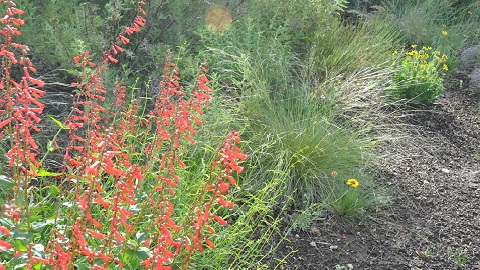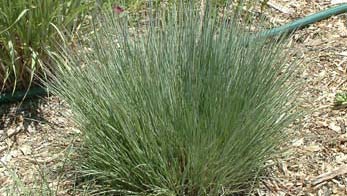Curl-leaf Mountain Mahogany in the Landscape
 January 2009
January 2009
Cercocarpus ledifolius
Description
Curl-leaf mountain mahogany is a marvelous large shrub to small tree that would look good in any ornamental landscape, but is especially adapted for low-water landscapes. It is the only broadleaf evergreen tree in the Intermountain West, and as such it offers an interesting winter contrast to the standard landscape conifer. It achieves a rather gnarly and quite intriguing shape with age. Seeds have long, cork-screw, feather-like plumes that cover the tree, creating an almost fuzzy appearance from a distance. The leaves are distinctively aromatic, evergreen and, curled under, thus its common name.
Cultural Requirements:
| Native habitat | Dry hills and rocky slopes throughout the West at elevations from 5,000 to 10,000 feet |
| Soil | Well drained, tolerates poor soil conditions; prefers coarse, rocky slopes; pH 6.0 to 9.0 |
| Cold Tolerance | Zones 3-8 |
| Drought Tolerance | High |
| Salt Tolerance | Unknown |
| Sun/Shade Preference | Full sun to part shade |
| Transplanting | Deep tap root makes it difficult to transplant |
| Propagation | Seed or hardwood stem cuttings |
| Maintenance | Prune in winter; tolerates hedging or shearing |
| Pest problems | Browsed by deer |
Landscape Value:
| Use in the Landscape | Use as a screen or for reclamation, soil stabilization, cover for wildlife; becomes multi-stemmed as a seedling; it needs training to achieve a single-trunk tree form. | |||||||||||||||||||||||||||
| Leaves | Broadleaf evergreen; shiny, dark green and leathery | |||||||||||||||||||||||||||
| Flowers | Small, inconspicuous, pale rose | |||||||||||||||||||||||||||
| Color |
|
|||||||||||||||||||||||||||
| Fruit (seedheads) | Long, dry achene with a 2- to 3-inch plume attached | |||||||||||||||||||||||||||
| Form | Upright shrubby | |||||||||||||||||||||||||||
| Texture | Coarse | |||||||||||||||||||||||||||
| Ultimate Size | 8 to 15 feet | |||||||||||||||||||||||||||
| Rate of Growth | Slow | |||||||||||||||||||||||||||
| Plant Community | Parkland, pinyon-juniper, shrub steppe, mountain brush | |||||||||||||||||||||||||||
| Availability | ||||||||||||||||||||||||||||
| Cultivars | None of ornamental value | |||||||||||||||||||||||||||
Propagation:
To start seed indoors soak seed in hydrogen peroxide for up to 24 hours. Rinse well. Cold, moist stratify for 30 to 60 days. Sow seed into container and cover with ¼ inch soil. To sow seed outdoors, use a generous amount of seed and cover with ¼ inch of soil. Sow in fall and watch for germinated seedlings the following spring. Cuttings should be collected in the spring from the previous season’s growth.
Additional Photo:
Photo credits: Roger Kjelgren


References
- Cerny, T., L. Rupp, C. Reid, and M. Kuhns. 2002. Selection and Culture of Landscape Plants in Utah: A guide for southwestern and central Utah. Utah State University Extension Bulletin HG 500.3 URL: http://extension.usu.edu/files/publications/publication/HG_500_3.pdf
- Mee, W., J. Barnes, R. Kjelgren, R. Sutton, T. Cerny, and C. Johnson. 2003. Waterwise: Native Plants for Intermountain Landscapes. Utah State University Press, Logan, UT.
- Rupp, L., R. Kjelgren, J. Ernsten, and W. Varga. 1997. Shearing and Growth of Five Intermountain Native Shrub Species. Journal of Environmental Horticulture 15(3):123-125.
- Zeidler, Scott; Justin, John. 2003. Propagation protocol for production of field-grown Cercocarpus ledifolius Nutt. plants (2+0); Utah Division of Forestry, Fire and State Land - Lone Peak Nursery, Draper, Utah. In: Native Plant Network. URL: http://www.nativeplantnetwork.org (accessed 2 January 2009). Moscow (ID): University of Idaho, College of Natural Resources, Forest Research Nursery.
- This fact sheet belongs to a series of fact sheets about Intermountain West native trees, shrubs, perennials, and grasses called “Native Plants in the Landscape.” Look for others in the series by visiting http://extension.usu.edu/htm/publications, then clicking on ‘Horticulture’ and ‘Native Plants’.
Authors
Heidi Kratsch, Extension Ornamental Horticulture Specialist; Graham Hunter, Research Associate, Center for Water Efficient Landscaping
Related Research












